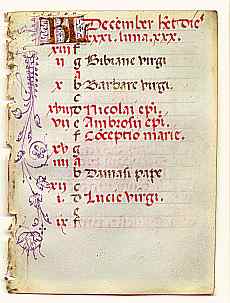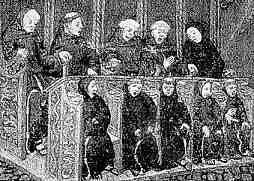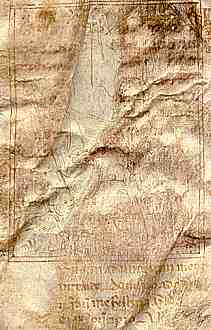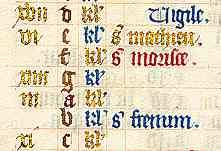 |
|
Personal
Devotion and Books of Hours (2) |
|
There
are some very famous and lavish books
of hours, illustrated by the most celebrated artists of the day, and
glossy publications often focus on these. There were also vast numbers
produced commercially, for sale to the aspiring middle classes who couldn't
afford a private contract with the Limbourg brothers. The artwork of these
may look awkward, even naive, but they had fancy initials treated with
gold leaf, elaborate
floral and foliate borders and a program of miniatures which was not unvarying, but followed certain patterns with plenty of
room for special requests by the patrons or buyers. So what are these
and what are they for?
|
|
| At its core, the book of hours was a simplified form of the divine office, able to be slipped into a normal working day. It also contained a range of other devotional literature, which was not absolutely standardised. The owners of books of hours had considerable personal choice in the exact makeup of each work. Because these works were so prolific, surviving examples are legion, and as many are regarded by the art cognoscenti as not of the highest quality, there has probably not been as much work done as there should have been on the full variability of these works. |
| While those in the traditional Benedictine orders were required to spend many hours each day reciting their divine office, other clergy had different time consuming tasks. Augustinians running hospitals, friars preaching and parish clergy tending their flocks needed a simpler routine. The Hours of the Virgin Mary, possibly written as early as the 11th century, became popular with them. It was short, and did not vary from day to day like the more formal offices. Its rise in popularity also coincided with with the increasing popularity of the cult of the Virgin in the 13th and 14th centuries. This became the basis for the daily devotions of the laity. |
|
Monks in choir. |
| The very earliest known books of hours date from the 13th century. They increased in popularity in the 14th century, and by the 15th century were bestsellers in medieval terms. In the main centres of production, particularly in Flanders and the Netherlands, production shops churned them out and exported them overseas. Nevertheless, they were prestige items, but prestigious for more ordinary people than the lavish volumes produced for the uppermost aristocracy in earlier times. They became most popular in Flanders, the Netherlands, France and England, less popular in Italy, although there are many examples both plain and fancy from that country, and less popular again in German speaking countries where other styles of prayerbooks prevailed. |
 |
The heart of the work was the Hours of the Virgin, the text which actually defines a codex as a book of hours, whatever other material it may contain. The office for each of the hours contined Psalms, versicles, responses, readings and prayers, so while it was a simplified form of the divine office, it contained the various elements of the office as said in church by the clergy. For a lay person to perform this assiduously would still have been a time consuming daily set of tasks. It also contained its own set of miniatures, which did not strictly illustrate the text, but rather various episodes in the life of the Virgin. The most comon program followed the events of the Nativity, but a more solemn alternative was a cycle of the Passion, with the role of the Virgin prominently displayed. Images as well as words were significant aids to religious contemplation in the book of hours. |
| A miniature of the entombment of Christ, with the Virgin standing at the back, precedes the text for compline in the Hours of the Virgin in a 15th century book of hours (National Library of Australia MS 1097/9, f. 50r), by permission of the National Library of Australia. |
| Other, even more simplified, versions of the hours appeared in these works, consisting largely of hymns, versicles, responses and prayers, to allow for an even more discreet and rapid observance. Two which were very usual were the Hours of the Cross and the Hours of the Holy Spirit. The very battered and faded illustration at right shows a miniature representing Pentecost to illustrate the latter. The image is only a pen sketch, and probably was never completed. And yes, it is very hard to make much of it on the screen, but the heavenly radiance with the dove is at centre top, and various shadowy figures emerge below. Trust me. |
|
| Leaf from a late 15th century Italian book of hours, with unfinished miniature of Pentecost and text of the Hours of the Holy Spirit, from a private collection. |
| It is not strictly correct to call a book of hours a liturgical book, as it was not used by the clergy in church, but it had many features in common with these, not the least of which were the texts for the offices themselves. Like the formal liturgy, they also varied from diocese to diocese, and the term use; as in use of Rome, use of Utrecht, use of Sarum; is used to describe them, although even this implies a greater uniformity of content than actually exists. The actual Hours of the Virgin varied somewhat according to use, as did the inclusion of certain other texts, but these were also partly at the discretion of the owner or buyer of the work. |
 |
Like psalters, breviaries and other formal liturgical books, the work generally started with a calendar indicating the church feasts and saints' days throughout the year. These are also an indicator of the use of the work, as particular local saints were often included. The example at left has a rather conservative selection of early Christian saints and martyrs. The more important feasts are indicated in red. |
| Calendar leaf for December from a late 15th century Italian book of hours, from a private collection. |
| On the other hand, this sample from a French language book of hours calendar for September displays a number of northern French saints. There is an interesting anomaly however, as the day which should be the feast of St Fermin is labelled Fremim, suggesting that the scribe was perhaps unfamiliar with the name of this local saint, and hinting that perhaps the book was actually produced somewhere else. This did happen as Flanders, for example, produced works for export to France and England. Note also that this elegant little sample has a three layered hierarchy of feasts, as delineated in gold, red and blue. |
|
| |
Segment from a calendar leaf for September from a French book of hours, from a private collection. |
| The book of hours was not, however, just a single text, but a library of texts for personal devotions for various occasions. |
|
 previous page
previous page |
 Categories
of Works Categories
of Works |
|
 |
 |
 |
 |
 |
 |




